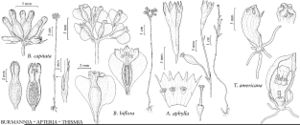Thismia americana
Bot. Gaz. 57: 123, plates 7–11. 1914.
Stems white, 0.3–1 cm. Leaves appressed, white, subulate to ovate, 2–4 × 1.5–3 mm. Flowers white with faint blue-green lobes, 8–15 mm; perianth tube slightly urceolate, 6-lobed; outer lobes recurved, ovate, 2.5–4 mm; inner lobes erect, convergent to connate at apex, linear; annulus 0.5–1.5 mm wide; staminal connectives dilated, connate, forming tube proximal to annulus. Capsules 2–3 mm.
Phenology: Flowering summer–early fall.
Habitat: Prairie
Elevation: 200 m
Discussion
Of conservation concern.
Thismia americana was observed and collected between 1912–1916 from a single site, in a prairie near Chicago, Illinois. It is now possibly extinct. Numerous attempts to relocate the species have been unsuccessful (L. A. Masters 1995); because only a small part of the minute plant is above the level of soil and moss, it could be easily overlooked. This species is believed to be most closely related to T. rodwayi F. von Müller of Australia and New Zealand, presenting a puzzling pattern of distribution (P. J. M. Maas et al. 1986).
Some authors (e.g., R. M. T. Dahlgren et al. 1985; Angiosperm Phylogeny Group 1998) have proposed Thismiaceae to include Thismia and allied African and South American genera.

